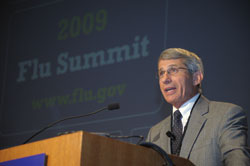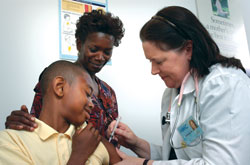Fall flu outbreak of concern to NIH, Fogarty experts
July - August, 2009 | Volume 8, Issue 4

NIAID Director Dr. Anthony Fauci is optimistic
that the H1N1 flu virus will not become more
potent this fall.
Researchers at Fogarty's epidemiology division and at the National Institute of Allergy and Infectious Diseases are working to identify patterns and solutions to a potential H1N1 autumn flu pandemic centered on schools.
"We are doing everything possible to monitor this virus and protect the American people," Health and Human Services Secretary Kathleen Sebelius said at a flu summit for regional, state and local leaders held on the NIH campus in July.
Joined by Department of Homeland Security Secretary Janet Napolitano and Education Secretary Arne Duncan, Sebelius outlined federal efforts to meet the challenge.
The measures, including early clinical trials of a vaccine against A/H1N1 and federal aid to localities for preparedness, are based on a four-pronged strategy of surveillance, mitigation, vaccination and communication, she said.
Based on early post-outbreak work by Fogarty's Dr. Mark Miller and colleagues, Sebelius acknowledged that "young people have been disproportionately impacted by this virus."
In a
New England Journal of Medicine article Miller and co-authors reported that in the new epidemic that first appeared this spring in Mexico "sharp increases were noted in the infection and mortality rates of people age 5 to 59, who represented 87 percent of deaths, compared to 17 percent during the past three normal flu seasons in Mexico."

Photo courtesy CDC
Young people, like this 13-year-old, are one of
the high priority target groups for vaccination
against the H1N1 virus.
"Given the relatively rapid global spread of this newly described pathogen, early identification of risk groups for severe pneumonia can aid in prioritizing vaccines and antivirals in the likely setting of limited supplies," according to the article.
The authors suggest that exposure to previous pandemics by people born before 1957 may confer some protection from the H1N1 virus, adding that "the age-stratification profile of risk outlined from this dataset provides a possible basis for control strategies based on the biological plausibility of partial protection from earlier exposure."
An H1N1 strain, popularly called "swine flu," circulated in the United States in 1976. "However, unlike 1976, epidemiologic evidence from this outbreak indicates continuous chains of person-to-person transmission," the article said. "While humans have previously been exposed to the A/H1N1 sub-type, this novel virus has made a host-species jump with sustained human to human transmission."
By mid-summer H1N1 had spread to even the most remote places on Earth, including Afghanistan, the Himalayas, Sudan and numerous vacation destination islands.
NIAID Director Dr. Anthony Fauci announced in late July the creation of a network of medical research institutions in the United States to conduct quick clinical trials of potential vaccines based on a "seed virus" distributed to manufacturers soon after the 2009 H1N1 was isolated.
Initial studies will look at whether one or two 15 microgram doses of H1N1 vaccine are needed to induce a potentially protective immune response in healthy adult volunteers (age 18 to 64) and elderly people (65 and older). Researchers also will assess whether one or two 30 microgram doses are needed.
The doses will be given 21 days apart, testing two manufacturers' vaccines. If early information from those trials indicates that these vaccines are safe, similar trials in healthy children (age 6 months to 17 years) will begin.
A concurrent set of trials will look at the safety and immune response in healthy adult and elderly volunteers who are given the seasonal flu vaccine along with a 15 microgram dose of 2009 H1N1 vaccine.
The H1N1 vaccine would be given to different sets of volunteers before, after or at the same time as the seasonal flu vaccine. If early information from those studies indicates that these vaccines are safe, similar trials in healthy children (age 6 months to 17 years) will start.
In an
interview with
nature.com, Fauci was optimistic. "If you look at the molecular and genetic make-up of the virus from the very first isolates in early April compared to what we are seeing now ... it's virtually an identical virus everywhere. So it doesn't look like it is under pressure to mutate to a significant degree. We hope it stays that way for the autumn and winter season."
Results are expected to be available weeks after the trials begin.
More Information
To view Adobe PDF files,
download current, free accessible plug-ins from Adobe's website.